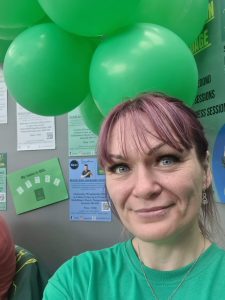In celebration of International Day of Sign Languages, Julia explains what her work involves. The challenges she experiences. And what made her want to be a BSL interpreter.

What does a typical day involve as a sign language interpreter?
Before I interpret in a meeting, I usually get preparation materials to look through. These could be meeting minutes, a slide deck, or an agenda. This gives me important information so that I have the correct understanding. And I can predict the language that they might use. It is also helpful to have details such as spellings of names or figures. This reduces the likelihood of error.
The most embarrassing error I have made was when someone was spoken of as “choking” which I misheard and interpreted as joking. As you can imagine, that really changed the message. And confused my large deaf audience, who luckily found it very funny, much to my dismay at the time as a trainee. Knowing the tone and content before makes that kind of thing far less likely.
Once we have prepped for an assignment, it is important to find out who the main participants are. I get their names and find out how they will be involved.
If I’m working in person, I place myself in the room in a space that is good for the deaf person to see me.
If I am working remotely, I need to know who to pin on our screen. Usually, this would be the deaf participants. It is also useful to have the participants list up. So that when someone speaks, I can see which name is theirs. I can indicate who’s speaking to our audience, who may only have us pinned on their screen.
Having a second screen to see any PowerPoint or screen sharing can also be useful.
When bookings run over an hour, say an in-depth meeting, interpreters work in pairs. Science shows that 15 minutes of processing language is our optimum period. After that mental fatigue starts to set in. That is why you will often see us taking turns.
Before we start working as a pair, we will usually agree on strategies for how to support each other. Sometimes the active interpreter may mishear something. And the interpreter who is not active can support by whispering a few missed words. Or clarify something to them.
What made you want to become a sign language interpreter?
I loved sign language straight away as a teenager. Other spoken languages go in one ear and out the other, but sign language makes sense to me. I love the huge amount I can express in the slightest movement or expression. It is a fascinating and beautiful language. It took me years to become fluent. And as confident as with my native language.
I am always learning and always will be. I love words and self-expression. It fascinates me how I can say things in a million different ways in spoken languages. And Sign Language is no different.
When I learned an advanced level of BSL I started working as a support worker in colleges. By then, I had got the bug and wanted to go further. On average, it takes seven years to qualify as an interpreter. This can be done at a university as I did or through the NVQ route.
What do you like most about your job?
People. I love the diversity and culture. I am privileged to be a witness to some of the most important events in people’s lives. Births, deaths, marriages, getting a puppy… Also just the everyday interaction and rapport.
What does your interpretation offer BSL users?
Empathy, emotion, humour, tone, insight and expression. I provide a higher level of accuracy. A participant can chip into the conversation rather than only communicate in the chat box. And just that elusive human touch.
What are the oddest things you’ve interpreted?
Training for someone to become a funeral director. Interpreting in court. And voicing over for the defendant that he was ‘chasing his ferret and didn’t mean to break in the garage m’lud. It was just the ferret went in first, and he had to be caught’. And, of course, finding myself fainting in a hospital theatre when someone had a toenail removed!